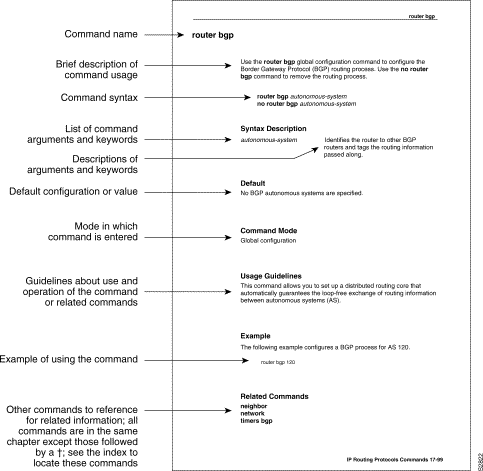This section discusses the objectives, audience, organization, and conventions of the Protocol Translator Configuration Guide and Command Reference.
This manual describes the tasks and the commands necessary to configure and maintain protocol translation in one or more of the following environments: Local Area Transport (LAT), TN3270, or XRemote. For information about routing X.25 and Transmission Control Protocol/Internet Protocol (TCP/IP), refer to the Router Products Configuration Guide and the Router Products Command Reference publications.
This publication is intended for users who are responsible for configuring and maintaining a router running protocol translation. This publication provides the following levels of audience support:
- A task-oriented portion that includes task overviews, expanded descriptions of tasks, and comprehensive configuration examples for less-experienced users who need to understand the tasks as well as the commands.
- A command reference portion and appendixes for experienced users who just need reference information to complete a task. This portion describes tasks only in the context of using a particular command; it does not describe how the tasks interrelate or provide comprehensive configuration examples.
All users should have prior networking experience and should be familiar with their own network topologies.
This publication is divided into three main parts, each identified by a divider page. Part 1 consists of an overview chapter and four chapters that provide task overviews, expanded descriptions of tasks, and comprehensive configuration examples. Part 2 consists of four chapters that provide in-depth descriptions of the commands necessary for configuring and maintaining your router as a protocol translator. The chapters in Part 1 parallel the chapters in Part 2. The third major part consists of six appendixes that provide reference information related to the use of the commands.
The chapters and appendixes in this manual are as follows:
- Chapter 1, "Product Overview," provides an overview of protocol translator functionality and hardware configuration options.
- Chapter 2, "Configuring LAT," describes how to configure the LAT protocol on your protocol translator.
- Chapter 3, "Configuring TN3270," describes how to configure your protocol translator for a TN3270 environment.
- Chapter 4, "Configuring XRemote," describes how to configure your protocol translator to support XRemote telecommuting services.
- Chapter 5, "Configuring Protocol Translation," describes how to establish and configure protocol translator connections.
- Chapter 6, "LAT Configuration Commands," describes the commands you use to configure the LAT protocol on your protocol translator.
- Chapter 7, "TN3270 Configuration Commands," describes the commands you use to configure your protocol translator for a TN3270 environment.
- Chapter 8, "XRemote Configuration Commands," describes the commands you use to configure your protocol translator to support XRemote telecommuting services.
- Chapter 9, "Protocol Translation Configuration Commands," describes the commands you use to configure your protocol translator to support protocol translation.
- Appendix A, "References and Recommended Reading," contains a list of publications related to networks.
- Appendix B, "Ethernet Type Codes," lists known Ethernet type codes for use with type code filtering configuration commands.
- Appendix C, "Regular Expressions," describes regular expressions, which can be used in addresses and fields for the X.25 switching feature, in chat scripts for the dial-on-demand routing (DDR) feature, and in access lists for Border Gateway Protocol (BGP) routes.
- Appendix D, "ASCII Character Set," provides code translations from ASCII characters to decimal numbers.
- Appendix E, "X.3 PAD Parameters," discusses the X.3 PAD parameters for terminal-handling functions such as baud rate, flow control, character echoing, and other functions used for a connection to an X.25 host.
For information on the following topics, refer to the applicable chapters in the Router Products Configuration Guide and the Router Products Command Reference publications:
- Understanding the user interface
- Loading system images, microcode images, and configuration files
- Configuring terminal sessions and modem support
- Managing the system
- Configuring interfaces
- Configuring Frame Relay
- Configuring Switched Multimegabit Data Service (SMDS)
- Configuring X.25
- Configuring TCP/IP
This publication uses the following conventions:
- Ctrl and the symbol ^ represent the key labeled Control.
- For example, the combination Ctrl-D means hold down the Control key while you press the
D key.
- A string is defined as a nonquoted set of characters.
- For example, when setting up a community string for SNMP to "public," do not use quotes around the string, or the string will include the quotation marks.
Command descriptions use these conventions:
- Commands and keywords are in boldface font.
- Arguments for which you supply values are in italic font.
- Optional elements are shown in square brackets ([ ]); alternate optional elements are separated by vertical bars.
- Alternative but required keywords are grouped in braces ({ }) and separated by vertical bars (|).
Examples use these conventions:
- Examples that contain system prompts denote interactive sessions, indicating that the user enters commands at the prompt. The system prompt indicates the current command mode. For example, the prompt
CPT(config)# indicates global configuration mode.
- Terminal sessions and information the system displays are in
screen font.
- Information you enter is in
boldface screen font.
- Nonprinting characters, such as passwords, are in angle brackets (< >).
- Default responses to system prompts are in square brackets ([ ]).
- Exclamation points (!) at the beginning of a line indicate a comment.
Note Means
reader take note. Notes contain helpful suggestions or references to materials not contained in this manual.
The following illustration explains the fields on a typical command reference page:


